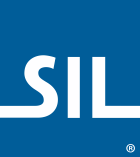EuroLatin (SIL) Keyboard Help
The EuroLatin keyboard enables you to type in all European languages which use Latin-script, and most Latin-script languages from the rest of the world. The keyboard is designed to be used with any Latin hardware keyboard. It uses simple sequences of symbol + character to type letters and other characters not available on a standard keyboard.
Fonts
Most of the characters in this keyboard are included in the fonts Calibri, Cambria, Arial, and Times New Roman, as well as many other fonts. Some of the characters in this keyboard are only supported by specialty fonts, like Code2000.
Complete Typing Charts
Lowercase Letters
Type the symbol on the left and then the letter (from the bottom row) to get the character in the chart.

Uppercase Letters
Type the symbol on the left and then the letter (from the bottom row) to get the character in the chart.

Digraphs
Type the characters in the bottom box to get the character in the top box.

Punctuation and Symbols
Type the characters in the bottom box to get the character in the top box.
Note that "\-" outputs the code for soft hyphen, code-point (173, U+00AD).

Numbers and Fractions
Type the characters in the bottom box to get the character in the top box.

Currency Symbols
Type the characters in the bottom box to get the character in the top box.

Prefix keys
Type the characters in the bottom box to get the character in the top box.

Technical Support
You can access this help again from the Keyboard Usage tool on the Keyman Desktop toolbar
Keyboard Source
This keyboard is available online at keyman.com/keyboards/sil_euro_latin
Change History
1.8: (6 Jul 2018) Ported to GitHub.
1.7: (25 Mar 2015) Added ș Ș ț Ț for Romanian, typed with @ + letter.
1.6: (17 Mar 2011) Minor corrections, added Indian Rupee Sign, Saltillo, and Guaraní support.
1.5: (30 Nov 2010) Updated Keyboard Usage for Keyman Desktop, standardised keyboard name, added g with stroke.
1.4: (15 Jul 2010) Minor corrections, updated documentation.
1.3: (25 May 2010) Added 180 letters and 20 other characters, including lowercase and capital schwa, open e, open o, ezh, oi, yogh, glottal, and palatal n. The keyboard now supports every Latin-script European language and a greatly increased range of Latin-script languages from Africa, Asia, Oceania, and the Americas.
1.2.1: (9 Feb 2010) Improved list of supported languages.
1.2: (1 May 2009) Added Serbian (Latin-script) characters from Latin Extended-B Unicode range.
1.1.1: (12 Aug 2008) Added ǫ and Ǫ.
1.1: (21 Jan 2008) Hosting at eurolatin.keymankeyboards.com.
1.0.5: (22 May 2007) Added b, d, f, h, m, n, p, r, s, t, w and y with dot above.
1.0.4: (19 Jan 2007) Fixed upper case thorn T\H (was wrongly t\H).
1.0.3: (7 Aug 2006) Added 1/3, 2/3, 1/8, 3/8, 5/8, 7/8 symbols, fi and fl ligatures, and the following symbols: †‡‰–—•™…. Keyboard source is now available.
1.0.2: (14 Jul 2006) Updated documentation to include i\j and I\J (already in the keyboard).
1.0.1: Changed \ae, \ij, \ng, \oe, \ss, \th, \AE, \IJ, \NG, \OE, \TH to a\e, i\j, n\g, o\e, s\s, t\h, A\E, I\J, N\G, O\E, T\H to avoid conflicts.
1.0.0: Initial release.
© 1994-2018 SIL International
All Documentation Versions
- EuroLatin (SIL) Keyboard Help 3.0.2
- EuroLatin (SIL) Keyboard Help 3.0.1
- EuroLatin (SIL) Keyboard Help 3.0.0
- EuroLatin (SIL) Keyboard Help 2.0.4
- EuroLatin (SIL) Keyboard Help 2.0.3
- EuroLatin (SIL) Keyboard Help 2.0.2
- EuroLatin (SIL) Keyboard Help 2.0.1
- EuroLatin (SIL) Keyboard Help 2.0
- EuroLatin (SIL) Keyboard Help 1.9.6
- EuroLatin (SIL) Keyboard Help 1.9.5
- EuroLatin (SIL) Keyboard Help 1.9.4
- EuroLatin (SIL) Keyboard Help 1.9.3
- EuroLatin (SIL) Keyboard Help 1.9.2
- EuroLatin (SIL) Keyboard Help 1.9.1
- EuroLatin (SIL) Keyboard Help 1.9
- EuroLatin (SIL) Keyboard Help 1.8.1
- EuroLatin (SIL) Keyboard Help 1.8




